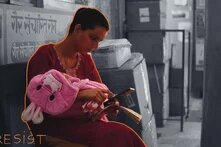While the voices of women in Zambia have often been overlooked throughout history, feminist movements are fighting for social justice and equality. Is feminism a colonial construct or the key to liberation?

Sixty years after the dramatic shift from colonial domination to democracy - when Zambians cried out “Kwacha 1” (Dawn) and children in the streets echoed “Ngwee 2 ” (Bright) - Zambia is eager to preserve independence by sustaining its tradition. But the critical question remains: whose tradition? While the names of male freedom fighters against British colonial rule are celebrated with ease, the memory of women who led powerful movements often remains subdued, if not erased entirely.
Feminism has many definitions and interpretations. In this context, it refers to the socio-political movement led by women, girls, and allies striving for social justice, freedom from systemic oppression, and gender equality. These feminist movements are often driven underground, as they challenge entrenched patriarchal structures rooted in colonial history and maintained in the postcolonial state.
Women were pivotal in the fight against colonialism, though their contributions have seldom been spotlighted beyond a footnote in history. Colonial systems imposed hierarchies that prioritized men over women - systems that persisted even after Zambia gained independence. As a result, many postcolonial nations, including Zambia, continue to struggle with achieving gender equality. While men regained autonomy and power after independence, women remained systematically excluded.
There are those, including women, who argue that feminist movements - despite the advances in women’s ability to work, vote, and own property - are tactics devised by colonizers to destabilize traditional family structures under the guise of women’s rights. On the contrary, feminist movements pushed to the margins argue that postcolonial societies have adopted “traditions” created by their oppressors and that feminism is a necessary tool to liberate communities from the enduring chains of colonial oppression. These ‘underground’ feminisms are those that progressively push for systemic change, challenge the status quo, and critically interrogate hidden systems of power.
A review of feminist figures from Zambia’s past and present, along with their impact on the future, can help address the pressing question: Is feminism a colonial construct designed to sustain hegemonic domination, or is it the tool that will free postcolonial societies from systemic oppression? The voices of these women, coupled with insights from historians and activists, reveal the gaps and opportunities in building a more gender-equal world through the decolonization movement.
A Historical Perspective of Feminism in Zambia
When colonizers arrived in Zambia, they strategically recognized male chiefs' authority - even in cases where female chiefs held higher ranks or greater influence. Mulenga Kapwepwe, award winning Zambian historian and author, recounted during a tour of Lusaka's history how colonial systems actively undermined female leadership. Before colonization, many Zambian societies were matriarchal or balanced in gender authority, with women revered for their roles as life-givers and leaders. Western patriarchal ideals disrupted these structures, delegitimizing women’s authority even in cultures where women held god-like status.
The Women’s History Museum of Zambia, co-founded by Mulenga Kapwepwe, explores how women shaped Zambia’s decolonial movements. Through the Leading Ladies animated podcast series, the museum highlights stories of women warriors and leaders who challenged colonial systems and fought for justice.
One prominent figure featured in the podcast is freedom fighter Julia Mama Chikamoneka, who protested colonial oppression and Nazism by leading women to march baring their breasts as a symbolic act of resistance.
In Zambian tradition, exposing one’s breasts is a powerful form of protest by women. Colonial views, however, labelled nudity as obscene, reducing its cultural significance. This colonial perception persists in conservative attitudes today, where women’s bodies are policed, and victims of violence are blamed based on subjective judgments about their clothing - or lack thereof.
Following independence, women faced further marginalization as a new patriarchal hierarchy emerged, vilifying women leaders through the state and the church. Alice Lenshina Mwanalesa, for instance, founded the Lumpa Church and led a powerful movement rooted in faith and justice. Yet she was persecuted by Zambia’s first president and celebrated Independence freedom fighter, the late Dr. Kenneth Kaunda of the United National Independence Party (UNIP) and the United Church of Zambia (UCZ) urged on by the colonial administration3. This persecution led to Lenshina’s imprisonment and the state-sanctioned massacre of over 1,000 Lumpa Church members, effectively dismantling her movement and limiting women’s leadership in the postcolonial era.
A silent state is not a peaceful state
Historically, Zambia had an established feminist ethos long before the term “feminism” was introduced. Parallels between contemporary activism and the nation’s past, show that feminist ideals have deep roots in Zambian society. However, a facade of gender equality in Zambia tries to hide the escalating violence against women and girls - such as rape, child marriage, abductions, and inadequate systemic responses.
Subilo Malema, Operations Lead at Safety First for Girls (SAFIGI) Outreach Foundation, represents a new wave of activists integrating decolonial methods into youth advocacy. Reflecting on her experiences, Subilo highlights the resistance youth protesters face, particularly criticism focused on what girls are wearing while they protest. Conservative sentiments often condemn girls and women wearing “mini-skirts and shorts” during protests, accusing them of disrupting traffic and undermining Zambia’s identity as a Christian nation. Both the church and government advocate for strict dress codes for women: covered arms and chests, skirts below the knees, and hidden midriffs - rules often reinforced from primary school through religiously affiliated education systems.
“A silent state is not a peaceful state,” Subilo, also a law graduate, asserts. “In the last quarter of 2024, there were 15 reported cases of gender-based violence (GBV) every hour, most of them affecting women and girls. Of the 10,782 cases reported, only 1,070 proceeded to court.”
SAFIGI Outreach Foundation is a youth and feminist led organization working to increase safety conditions of marginalized girls through a Holistic Safety Analysis and Intervention tool. This tool was co-created by girls, women and allies, creating solutions from the ones oppressed in a highly patriarchal society. The result was a blueprint on Holistic Safety and a safety report addressing the needs of girls post-COVID 19. Despite its decade-long track record of impact, SAFIGI has never received core funding. Grassroots social movements are forced to conform to the policies and trends set by Western donors to survive, as the aid industry shapes the direction of activism in Zambia.
Zambia’s 2024 national budget, heavily influenced by the country’s indebtedness to the IMF and other lenders, allocated just 0.54 percent of its 178 billion kwacha (~6.4 billion USD) to women, girls, and youth combined, Subilo notes. This glaring underinvestment disenfranchises women and girls, forcing them to rely on external aid to bridge the budget deficit.
The deficit is one of the major challenges underground feminist movements face as they navigate sustainability and impact. On the one hand, underground feminist movements require support to withstand coordinated pushback and create lasting change. On the other hand, the NGO-fication of these movements risks subsuming grassroots efforts into the aid-driven development agenda, which prioritizes capacity building while potentially diluting their transformative power.
NGO-fication and the Aid Industry’s Impact on Feminist Movements
NGO-fication occurs when grassroots movements become institutionalized to align with the agendas of funders, who are predominantly based in the Global North. Liberation movements are thus transformed into development theories created, circulated, and appropriated by Western institutions. These institutions, having shifted from colonizers to funders of the so-called "Third World," gave rise to the aid industry. This industry reproduces local hierarchies by "going through the men," relying on male leaders to influence “empowerment” projects. As a result, aid-dependent communities often lose the agency to set their own targets and indicators, as external "help" imposes its objectives.
The limitations of aid frameworks hinder feminist movements working in the margins. Aid-driven objectives and scarce resources fragment movements led by youth and women. Additionally, politics shape development priorities, with national governments often narrowing their focus to align with political agendas, in contrast to the broader objectives of the United Nations’ development agenda.
A fundamental driver of the aid industry is the exploitation of poverty and suffering. High-salaried positions in the non-profit sector depend on indicators that are often far removed from the core issues - such as core safety needs found by Safety First for Girls - thereby perpetuating problems that aid organizations can continue to address. A truly holistic approach to girls’ safety could initiate meaningful and sustainable power shifting in a decolonial method that challenges the perpetuation of aid as a self-sustaining industry.
The potential outcomes of supporting underground feminist movements, intertwined with decoloniality in Zambia, may appear as radical as the struggle against colonial rule itself. These power dynamics underscore the inherent conflict between colonialism and feminism, revealing that movements challenging oppressive systems are more deeply rooted in indigenous cultures than in entrenched colonial ideals. By embracing a decolonial approach, more inclusive feminist practices can emerge.
Ultimately, feminisms pushed to the margins are championing broader justice in governance and societal structures that challenges the colonial notion that holds that only a man can liberate a nation – a woman.
Footnotes
- 1
Kwacha means Dawn in the Nyanja - a Zambian language. It’s also the name of the Zambian and Malawian currency.
- 2
Ngwee means Bright in Chichewa - a Zambian language. It’s also the name of the smallest denomination of the Zambian currency.
- 3
Zambia, as part of the commonwealth of former British colonies, maintained its ties with the British colonial administration.

